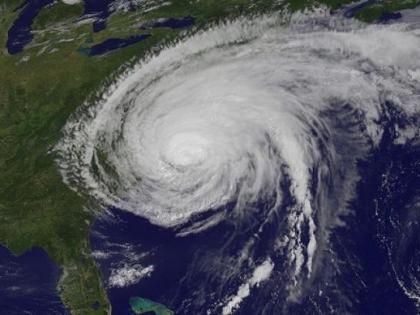Explained: How cyclones get their unique names
By Lokmat English Desk | Published: May 16, 2020 06:15 PM2020-05-16T18:15:26+5:302020-05-16T18:29:18+5:30
It is no secret that cyclones that form in every ocean basin across the world are named by the ...

Explained: How cyclones get their unique names
It is no secret that cyclones that form in every ocean basin across the world are named by the regional specialised meteorological centres (RSMCs) and Tropical Cyclone Warning Centres (TCWCs) Presently, there are as many as six RSMCs in the world, including the India Meteorological Department (IMD), and five TCWCs. Let us have a detailed look at how these cyclones get their names.
How are naming the cyclones take place?
A group of nations called WMO/ESCAP (World Meteorological Organisation/United Nations Economic and Social Commission for Asia and the Pacific), that comprised India, Bangladesh, Myanmar, Maldives, Pakistan, Oman,Sri Lanka and Thailand, decided to start naming cyclones in the region. After these countries sent in their suggestions, the WMO/ESCAP Panel on Tropical Cyclones (PTC) would finalise the list. The list of cyclone names that are released by the IMD last month, were provided by these countries. The IMD has issued an alert for Cyclone Amphan, which is forming over the southeast Bay of Bengal and adjoining south Andaman sea.
Why is it important to name cyclones?
Naming the cyclones makes it easier for people to remember them. Apart from this, it also helps the scientific community, the media, the disaster managers etc. It would be easy to identify a cyclone, ring the emergency bells on its development and raise warnings to increase community preparedness. While picking names for cyclones, there are setof rules that countries need to follow. If these rules and guidelines are following, the name is accepted by the PTC and finalises the selection.
The guidelines which needs to follow
The given name should be neutral to politics and political figures, religiuos believes, cultures, and gender. Meanwhile, name should be chosen in such a way that it does not hurt the sentiments of any community or population. The name should not be rude and cruel in nature. It should be short, easy to pronounce and should not be offensive to any member. Eight letters will be the maximum length of the name and the presented name should be submitted with its pronunciation and voice over.
Here's the new list comprises of 169 names including 13 from India such as Gati, Tej, Aag, Neer, Vyom, Jhar, Jaladhi, Murasu, Probaho, Prabhanjan, Ghumi, Ambud and Vega. The new list starts with Nisarga (shared by Bangladesh), Gati (India), Nivar (Iran).
| Bangladesh | Nisarga | Biparjoy | Arnab | Upakul | Barshon | Rajani | Nishith |
| India | Gati | Tej | Murasu | Aag | Vyom | Jhar | Probaho |
| Iran | Nivar | Hamoon | Akvan | Sepand | Booran | Anahita | Azar |
| Maldives | Burevi | Midhili | Kaani | Odi | Kenau | Endheri | Riyau |
| Myanmar | Tauktae | Michaung | Ngamann | Kyarthit | Sapakyee | Wetwun | Mwaihout |
| Oman | Yaas | Remal | Sail | Naseem | Muzn | Sadeem | Dima |
| Pakistan | Gulab | Asna | Sahab | Afshan | Manahil | Shujana | Parwaz |
| Qatar | Shaheen | Dana | Lulu | Mouj | Suhail | Sadaf | Reem |
| Saudi | Jawad | Fengal | Ghazeer | Asif | Sidrah | Hareed | Faid |
| Sri Lanka | Asani | Shakhti | Gigum | Gagana | Verambha | Garjana | Neeba |
| Thailand | Sitrang | Montha | Thianyot | Bulan | Phutala | Aiyara | Saming |
| UAE | Mandous | Senyar | Afoor | Nahhaam | Quffal | Daaman | Deem |
| Yemen | Mocha | Ditwah | Diksam | Sira | Bakhur | Ghwyzi | Hawf |
After Hawf, the list moves on to Urmi, Neer, Pooyan etc.
| Bangladesh | Urmi | Meghala | Samiron | Pratikul | Sarobor | Mahanisha |
| India | Neer | Prabhanjan | Ghurni | Ambud | Jaladhi | Vega |
| Iran | Pooyan | Arsham | Hengame | Savas | Tahamtan | Toofan |
| Maldives | Guruva | Kurangi | Kuredhi | Horangu | Thundi | Faana |
| Myanmar | Kywe | Pinku | Yinkaung | Linyone | Kyeekan | Bautphat |
| Oman | Manjour | Rukam | Watad | Al-jarz | Rabab | Raad |
| Pakistan | Zannata | Sarsar | Badban | Sarrab | Gulnar | Waseq |
| Qatar | Rayhan | Anbar | Oud | Bahar | Seef | Fanar |
| Saudi | Kaseer | Nakheel | Haboob | Bareq | Alreem | Wabil |
| Sri Lanka | Ninnada | Viduli | Ogha | Salitha | Rivi | Rudu |
| Thailand | Kraison | Matcha | Mahingsa | Phraewa | Asuri | Thara |
| UAE | Gargoor | Khubb | Degl | Athmad | Boom | Saffar |
| Yemen | Balhaf | Brom | Shuqra | Fartak | Darsah | Samhah |